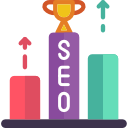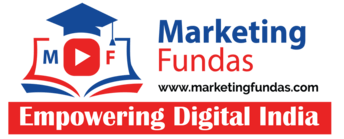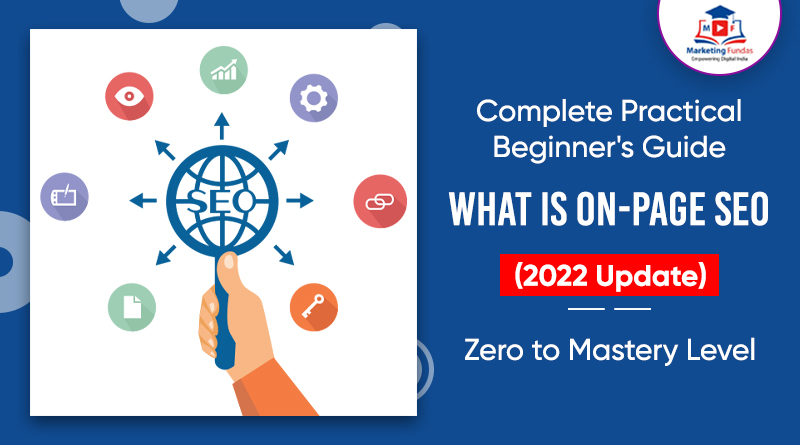On-page SEO has the ability to drive a tonne of new customers and visitors to your website.
Furthermore, on-page SEO is entirely up to you since you get to choose the particular topic and/or goal of each page. The target audience for that page is up to you to choose. Additionally, you get to choose which keywords and phrases you want to concentrate on.
This can be terrifying and empowering at the same time. We’ve created this on-page SEO checklist to serve as a starting point for those who are unsure how to proceed.
Three key elements—on-page SEO, off-page SEO, and technical SEO—are used by Google’s algorithm to rank your website:
We’ll go over every aspect of on-page SEO below. In order to properly optimize your site and increase traffic and conversion rates quickly, read this comprehensive practical guide to what is SEO and how it works. This will help you understand the entire SEO concept.
✅ Without further ado, Let’s dive in……….
Have a look at what this guide entails
👉  What is On-Page SEO?
What is On-Page SEO?
On-page SEO also referred to as “on-site SEO,” is the process of optimizing web pages to be more user-friendly and search engine-friendly. The optimization of title tags, content, internal links, and URLs are typically common on-page SEO techniques.
This is slightly distinct from off-page SEO activities, which involve optimizing for signals that occur outside of your website (for example, backlinks). Also, use Snapchat for business if you want to expand your social media marketing strategies to boost brand awareness and visibility.
👉  Why is on-page SEO important?
Why is on-page SEO important?
The importance of on-page SEO can be attributed to the fact that it provides Google with a detailed description of your website and the benefits you offer users. It helps in the optimization of your website for both human users and search engine crawlers.
In order to rank and draw in new visitors, you must optimize your website for Google and other search engines in addition to creating and publishing it. Also, reach out to these Digital Marketing companies in Gurgaon who can help you get the best marketing services in an affordable range.
With its plethora of complex algorithms, Google is now much better at:
- Understanding of the actual search terms entered by users.
- delivering search results that correspond to user intent (informational, shopping, navigational).
On-page SEO is based on the page’s actual content. Everything on the website has the potential to have an impact on SEO, including text, metadata, multimedia content, HTML code, CSS, JavaScript, and more.
Although marketers frequently refer to the main text of the page when using the word “content,” this is what is generally referred to as content.
Any SEO marketing strategy should center on this since it is the main area of focus for search engines.
Your traffic will increase and your search presence will improve if you put effort into on-page strategies.
The most significant components of on-page SEO are covered in this guide.
🏆 Bonus: You can enhance your affiliate marketing skills if you want passive income for a long time. For that, you must follow this amazon affiliate program guide to start your affiliate journey from scratch to advanced.
👉  Top 20 On-Page Activities To Boost Your Rankings, Traffic, And Conversions
Top 20 On-Page Activities To Boost Your Rankings, Traffic, And Conversions
By concentrating carefully on these 20 areas, you can strengthen your content and authority while also boosting your rankings, traffic, and conversions.
1- Keyword Research
Finding the actual search terms that people are using to access search engines is known as keyword research. It also helps in capturing and holding the interest of your intended audience.
Effective keyword research generates additional benefits like the right audience is engaged, a rise in customer conversion, a rise in SERP position, and more.
🟡 Recommended: Get to know Top Digital marketing Skills to boost your digital career in the right direction and help you land a high-paying job.
2- E-A-T Concept
The framework used by Google raters to evaluate content producers, web pages, and websites as a whole is called E-A-T, which stands for Expertise, Authoritativeness, and Trustworthiness.
You must include the E-A-T concept in your SEO strategy.
High-quality content has always been valued by Google. It wants to make sure that websites that produce high-quality content receive better rankings and that websites that generate low-quality content receive less exposure.
There is a clear relationship between what Google views as high-quality content and what shows up in the search results.
- Google values only those websites that demonstrate expertise, authority, and trustworthiness (E-A-T).
- The creator, the content, and the website all play a role in determining E-A-T.
- Websites that publish YMYL (your money, your life) content should pay particular attention to E-A-T.
How to improve E-A-T SEO?
- Keep content accurate and up to date
- Audit your brand & content
- Build a content marketing framework
- Build the right backlinks with off-page SEO
- Get more mentions from trusted sources
- Get more reviews (and respond to them)
- Use or hire experts
- Flash your credentials
- Get a Wikipedia page
- Go easy on the ads
- Promote offsite
- Show your contact details
E-A-T helps in determining whether a website and each of its individual pages are reliable resources of knowledge about a particular subject that actually add value for users.
🟡 Recommended: To boost the off-page strategies in the right direction, you need to use the top-quality high DA PA Profile Creation Submission Sites which can help you get rich backlinks.
3- Title Tag
The title tag is an HTML tag that appears in the head section of every webpage and gives a brief description of the topical subject matter of the page it is on.
It is prominently displayed both in the browser window and on search engine results pages, where it is frequently used as a clickable link.
- Consider your title length. …
- Don’t overdo your keywords (or keyword stuffing)
- Take advantage of your brand
- Give every page a unique title
- Write for your customers
- Put important keywords first
For this reason, the title tag is occasionally disregarded even though it has little effect on organic rankings on its own.
To that end, make sure you’re optimising for this element because title tags that are missing, duplicated, or poorly written can all have a negative impact on your SEO results.
🟡 Recommended: To boost the off-page strategies in the right direction, you need to use the top-quality high DA PA Article Submission Sites list which can help you get rich backlinks.
4- Headlines
Want your website’s content to perform well on search results? Then don’t wait; start writing compelling headlines.
A blog post’s title may seem simple enough, but a strong headline can mean the difference between a click and an impression, so it’s crucial to craft them carefully.
How to Write SEO-Friendly Headlines
- Include keywords in your headlines.
- Use intellectual, emotional and spiritual words.
- Avoid bounces
- Understand your target audience.
- Include numbers in your catchy SEO-friendly headlines.
- Use strong adjectives.
- Keep to around 8 words.
To stand out on the SERPs, your headlines must pique users’ interests and persuade them to click through and read the rest of the content.
🟡 Recommended: Getting the right hosting services from a top hosting company will help you to strengthen your brand automatically and for that, you must go through this Bluehost Review 2022 to know which hosting plan will be great for your site.
5- Meta Description
Meta descriptions have been a crucial component of optimization since the beginning of SEO.
In the SERPs, meta descriptions—meta tags that describe the topic of the page—are frequently shown beneath the page title.
Although Google claims that meta descriptions have no direct effect on rankings, there is circumstantial evidence that better descriptions’ indirect benefits do.
How do I write a good meta description for SEO?
- On desktop, you can reach 158 characters and no more, and on mobile, 120 characters.
- Use verbs that are action-oriented. It receives the maximum clicks!
- Make it relevant and specific. Put that keyword in there and avoid writing duplicate meta descriptions!
- Make sure a meta description is present on each page of your website.
- Make unique page descriptions for each of your website’s pages.
- Do not mislead users.
- It provides a solution or benefit.
Optimizing meta description correctly can help improve:
- Click-through rate (CTR).
- Perception of the quality of the result.
- Perception of what your website offers all change.
👉 Also if you’re looking to create a website, blog, or online store, Bluehost can help you get started with a hosting plan tailored to your specific needs with 24/7 technical support.
6- URL Optimization
Short, keyword-rich URLs should be used for websites; dynamic URL structures should be avoided. First off, a URL structure with 3 to 5 words is more significant because it gives the website more authority.
One of the best practices is including keywords in a URL. Using specific keywords and proper URL structure will. Also, if you want to build an effective email approach then this complete guide to what is email marketing will help you to heighten your email open and click rates.
7- Don’t keyword stuff
We just went over a tonne of instances where keywords are both beneficial and essential for SEO. However, “keyword stuffing” is a mistake that a lot of beginners make when trying to improve their on-page SEO.
The SEO of your website and web pages may suffer from keyword stuffing, and readers and visitors may perceive it as spam.
#️⃣👉 Also, know how to use Hashtags effectively if you want to boost your social media engagement.
8- Header Tags
- Header tags (HTML elements H1–H6) are used to separate headings and subheadings from other types of text within your content (e.g., paragraph text).
- They can indirectly impact your rankings by:
- making content more user-friendly and enjoyable for visitors to read.
- Providing the search engines with context about your content that is keyword-rich
Also, get to know the top digital marketing tools which every marketer must use to make their online marketing efforts successful and effective.
How do you use header tags in SEO best practices?
- Use Header Tags To Provide Structure. …
- Break Up Blocks Of Text With Subheadings. …
- Include Keywords In Your Header Tags. …
- Optimize For Featured Snippets. …
- Only Use One H1. …
- Keep Your Header Tags Consistent. …
- Make Your Header Tags Interesting.
Although header tags are no longer as crucial to your site’s rankings as they once were, they still have a critical role to play for both your users and SEO.
👉 We’ve got the perfect resource for you if you want to learn more about what is digital marketing and how it works. Marketing Fundas offers advanced digital marketing courses to help you grasp the fundamental concepts and develop winning strategies.
9- Do Internal Linking
Internal linking in SEO is the process of creating a hyperlink to another helpful page on your website. (See how the phrase “SEO” in the previous sentence refers to a different Marketing Fundas blog post? It’s a good example.)
Internal links are crucial for on-page SEO because they direct readers to other pages on your website, retaining them there for a longer period of time and signaling to Google that your site is valuable and beneficial.
Furthermore, the longer visitors stay on your site, the more time Google has to crawl and index your website pages. In the end, this aids Google in learning more about your website and may help it appear higher in search engine results.
😀👉💻: Also make your off-page activity strong and help you faster go through this complete: Beginner’s Guide to What is Link Building: (2022 Update)
10- Add external links
Given that we just discussed numerous reasons why internal linking is so crucial for on-page SEO, it might seem counterintuitive to include external links all throughout your page. External links, however, are also significant.
Google will know that your page is credible and trustworthy if you externally link to other reliable websites. Google and your visitors both want to know that your website is well-cited.
🟡 Recommended: Want to start and boost your freelancing career with the right guidance then this complete guide to What is Freelancing: Ultimate Beginner’s Guide 2022 || (Zero to Mastery Level) is the go-to option for you
11- Site Speed
Your site must load quickly, whether it is being viewed on a desktop or a mobile device. Page speed is extremely important for on-page SEO.
Google is primarily concerned with the user experience.
Google is aware that visitors are less likely to stick around if your website loads slowly or erratically.
9 Quick Ways to Improve Page Loading Speed
- Choose a performance-optimized hosting solution
- Compress and optimize your images.
- Enable browser caching
- Leverage a content delivery network (CDN)
- Reduce your redirects
- Use asynchronous and defer loading for your CSS and JavaScript files
- Eliminate unnecessary plugins
- Cache your web pages
- Minify CSS, JavaScript, and HTML
Additionally, conversions and ROI may be impacted by site speed. Use Google’s PageSpeed Insights tool at any time to check the speed of your website.
🔷 Recommended: Go through this quick guide to what is domain name and what you need to know before choosing a strong domain.
12- SEO Writing
Writing content for search engines entails keeping both users and search engines in mind.
Writing effective SEO content requires a strategy that goes beyond simple keyword research and filling in the blanks.
Writing for SEO: The Essentials
- Think Keywords First. …
- Approach Keyword Research Like An Art. …
- Study The Competition For Keywords. …
- Target 1 Or 2 Keywords For Each Page Or Blog (Except Homepage) …
- Use Keywords Where They Matter Most. …
- Use Bold & Bullet Points Wherever Possible. …
- The Title Tag: Still The Most Powerful Element.
Simply generating content for the sake of SEO won’t do. Remember that you’re writing content for people who want value from your site—so that content must be high-quality, substantial, and relevant.
🏆 Bonus: Start a professional SEO Writing journey then this complete beginner’s guide to SEO Content Writing (Zero to Mastery Level) will help you kick-start effectively.
13- Image Alt-text
Image alt-text is the SEO for your image content. It provides information to Google and other search engines about the subject matter of your images, which is crucial given that Google now displays almost as many image-based results as text-based ones.
This implies that users could be finding your website through your images. However, you must include alt-text in your images for them to do this.
When adding image alt-text, bear the following in mind:
- Make it descriptive and specific.
- Make it contextually relevant to the broader page content.
- Keep it shorter than 125 characters.
- Use keywords sparingly, and don’t keyword stuff.
🔷 If you own a small business, you must read this comprehensive guide to what is WooCommerce and how to set up an online store using WordPress and the WooCommerce plugin.
14- Content Audit
The majority of content creators are so preoccupied with producing new content that they neglect to review what they already have. And it’s an error.
For the following reasons, auditing your current content is essential:
- Examine whether the goals and ROI of your current content are met.
- Identify whether the content information on your site is still accurate or has become stale (or even outdated).
- Analyze the content types that are most effective for you.
Regularly performing content audits will greatly benefit your SEO strategy. Content is a king, you must focus on your content so that it can help you optimize the major part of on-page activities.
🎃 Recommended: For best digital marketing results, get to know what is content marketing deeply & the proven content marketing strategy which can assist you in the right direction without any confusion and will help you to spread your rich content effectively.
15- User Engagement
Increasing the on-page SEO components of your website is only half the battle. The other half is ensuring that users do not leave your site abruptly, but rather stick around, engage with it, and return frequently.
Although it can be difficult to keep users interested, it is certainly possible. Focus on elements like site speed, user experience, and content optimization, among others, to boost user engagement.
🤑 Bonus: Get to know what is lead generation and how to generate more high-quality leads🧲 from your blog on a regular basis with less effort.
16- Structured Markup
Structured markup, also known as structured data, is the process of “marking up” the source code of your website to help Google find and comprehend the various components of your content.
The featured snippets, knowledge panels, and other content features you see when you conduct a Google search are all made possible by structured markup.
Additionally, it explains why sharing your content on social media presents your specific page information in such a tidy manner.
🟡 Recommended: Build an effective email approach then this complete guide to what is email marketing 📩 will help you to heighten your email open and click rates.
17- Mobile Responsiveness
Mobile responsiveness, or mobile-friendliness, describes your website’s usability on mobile devices.
Google only benefits sites that are optimised for faster mobile speeds—even for desktop searches. Mobile responsiveness matters a lot.
The selection of a website hosting service, site design and theme, and content layout that is readable and usable on mobile devices is crucial. If you’re unsure whether your own site is mobile-ready, then you can use Google’s Mobile-Friendly Test tool.
🟡 Recommended: If you are wondering how to become an affiliate for the top brands then reach out to this complete tutorial regarding what is affiliate marketing to get started easily.
18- Keyword Cannibalization
True or false? The more pages you target with a keyword, the higher you will rank on SERPs for that keyword.
False!
Multiple pages targeting the same keyword can lead to “keyword cannibalization,” which can negatively affect your SEO.
When you have multiple pages ranking in search results for the same keyword, you’re actually competing with yourself.
How To Fix Keyword Cannibalization
- Restructure Your Website. …
- Create New Landing Pages. …
- Consolidate Your Content. …
- Find New Keywords. …
- Use 301 Redirects
It’s important to find any instances of keyword cannibalization on your website and take immediate action to address them.
😀👉💻Selecting the right keywords is the heart of any targeting strategy and for this, you can reach out to high-quality PPC services in Delhi from Marketing Fundas to boost your online campaign effectively.
19- Page URLs
Your page URLs should be easy for readers and search engines to understand. They are crucial for maintaining the consistency of your site hierarchy as you develop internal pages such as blog posts, subpages, and other kinds of pages.
Here are some pointers for creating SEO-friendly URLs:
- Remove the extra, unnecessary words.
- Use only one or two keywords.
- Use HTTPS if possible, as Google now uses that as a positive ranking factor.
🟡 Recommended: Get expert website designing services in Delhi from Marketing Fundas. After asking you a few questions about your site and your style preferences, We’ll then create a fully designed site with custom content and images built-in for you.
20- Canonical tag
However, it’s sometimes impossible to avoid having two URLs with the same content. Using a canonical tag on your website is one way to stop this from turning into a duplicate content problem.
This tag accomplishes one straightforward task: it informs Google that one URL is equivalent to another, making it clear that even though two pages have the same content, they are actually one.
🏆 Bonus: Get to know the LinkedIn marketing strategies to spread your relevant content to brands and professions to boost your brand community value and loyal audience base.
👉  Conclusion
Conclusion
On-page SEO is crucial if you want to improve your website’s chances of showing up in the search results. Once your SEO strategies are complete, either make these changes to your website yourself or have someone else make them for you. We are here for you.
Reach out to Marketing Fundas and get full-fledged SEO assistance and get your site ranked at the top of the SERP. Regularly optimizing for on-site factors can help you increase traffic, rankings, and conversions.
💬✍ Feel free to comment below if you have any questions regarding digital marketing blogs & courses. We’d love to read your comments & assist you in solving your problems.
🏆👉 Also, read other quick guides mentioned below which will help you boost your digital journey. Contact Now to get best-in-class digital marketing services in Delhi from the Marketing Fundas experts team.
Happy Marketing! 😀👉📲💻📢
Recommended Blogs and Services
- What is affiliate marketing?
- What is blogging
- Facebook ad mistakes
- How to generate high-quality leads
- How to sell products online
- Linkedin marketing strategies
- Best digital marketing tools
- What is content marketing
- What is dropshipping
- How to start an e-commerce business
- Facebook group
- What is Twitter marketing
- What is youtube marketing
- What is Influencer marketing
- What is off-page SEO
- What is Google Analytics
- What is Social Media Marketing
- What is Email Marketing
- Snapchat Marketing
- PPC Services in Delhi
- Bluehost Review
- Social Bookmarking Sites List 2022
- Business listing Sites List 2022
- What is a Domain
- What is Search engine marketing
- Guest Posting Sites List
- What is Link Building in SEO
- Google My Business
- How to Generate More Leads and Sales
- Digital marketing Skills
- Article Submission Sites List
- Digital Marketing Course in Laxmi Nagar
- Web 2.o Submission Sites list
- SEO Companies In Ghaziabad 2022
- Free Classified Submission Sites List
- What is WhatsApp Marketing
- Profile Creation Sites 2022
- Classified Submission Sites List
- Best SEO Company In Ghaziabad
- Top 8 SEO Agencies In Gurgaon
- What is Content Writing
- What is Google Tag Manager
- Types of Web Hosting
- What is canva




It’s hard to come by knowledgeable people for this subject, but you sound like you know what you’re talking about! Thanks
Glad you found this article valuable. Thanks for your nice comment 🙂
Thank you so much for this useful informatiom,i have will surely utilize this knowledge in my future
Keep following Marketing Fundas blogs for more informative digital marketing tactics, jot down important points and enhance your strategies. 🙂✌
One of the best guides I ever read about SEO for beginners
Thank you and keep these good articles coming….
Glad you found this article valuable. Thanks for your nice comment 🙂
Keep following Marketing Fundas blogs for more informative digital marketing tactics, jot down important points and enhance your strategies. 🙂✌
Thanks for the detailed information regarding SEO types.
Thanks for your nice comment 🙂
Keep following Marketing Fundas blogs for more informative digital marketing tactics, jot down important points and enhance your strategies. 🙂✌
Pretty! This was an incredibly wonderful article.
Many thanks for providing this info.
This is very informative article .it will be helpful for everyone .i got so many important point and cleared my all doubt today. Thanks a lot .,